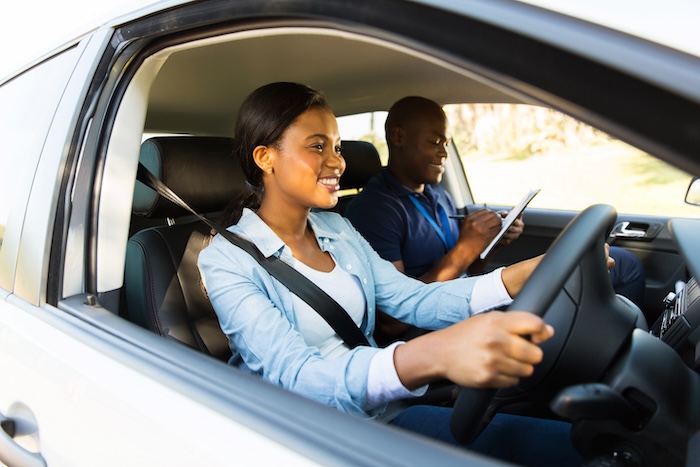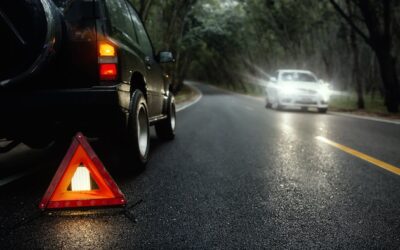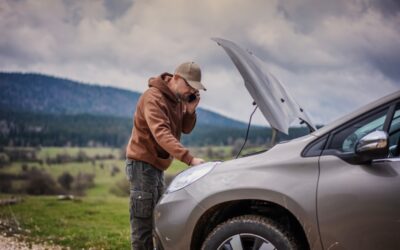During your driving test, your examiner will ask you two questions; a ‘show me’ and a ‘tell me’ question.
We’ve already covered the possible Show Me questions, so here we discuss the possible Tell Me questions you might be asked on your driving test.
Tell Me Driving Questions
There are 14 possible Tell Me questions. But again, your examiner will only ask you one.
- Tell me how you’d check the brakes are working before starting a journey
- Tell me where you’d find the cars recommended tyre pressures and how you’d check each tyre
- Tell me how you’d make sure your head restraint is correctly adjusted so it provides the best protection
- Tell me how you’d check the tyres have sufficient tread depth and are in a safe condition
- Tell me how you’d check the headlights and tail lights are working
- Tell me how you’d know if there was a problem with your anti-lock braking system
- Tell me how you’d check the indicators are working
- Tell me how you’d check the brake lights are working
- Tell me how you’d check the power steering is working before starting a journey
- Tell me how you’d switch on the rear fog lights and explain when you’d use them
- Tell me how you’d switch your headlights from dipped to main beam and explain how you’d know the main beam is on
- Open the bonnet and tell me how you’d check the engine has sufficient oil
- Open the bonnet and tell me how you’d check the engine has sufficient engine coolant
- Open the bonnet and tell me how you’d check you have a safe level of brake fluid
As you’ll see, these are pretty straightforward questions. They don’t require you to take any action. You just need to answer with what you would do, as clearly as you can.
Don’t worry if you need to think about the question first. If you’re unsure, it’s best to consider your response, rather than risk giving a wrong answer from the top of your head.
This Government video details how examiners expect you to answer each of these questions:
Below, we’ll list each question in turn, with a short response for each one.
Remember that these are all essential safety checks, and it’s important to stress that you’d only ever carry out any of these checks when it’s safe to do so. It might be a good idea to start any response by saying something like: “First I’d check my surroundings, including the area behind me and my blind spots, to make sure that there are no possible hazards around.”
How Would You Check The Brakes Are Working Before You Start The Journey?
Gently press the brake pedal just before you set off. The brakes should not feel spongy or slack, and the car should not pull to one side.
How Would You Check The Brake Lights Are Working?
The brake lights are located on the rear of your vehicle, and they’re activated when you push down on the brake pedal. You can check they’re working through either asking someone to stand behind your car and confirm they flash when you press the brake, or else you can check yourself by looking for reflections in the windows and doors around you.
Where Would You Find Out Information About Your Car’s Recommended Tyre Pressures?
Your car’s recommended tyre pressures will be listed in the car’s owner’s guide, on a sticker in the passenger side doorjamb and, sometimes, on the sidewall of the tyre itself.
The examiner may alternatively ask you how you’d check a tyre’s pressure. To do this, you’d use a pressure gauge. Remove the tyre’s valve cap, attach the gauge, and adjust the pressure accordingly based on your reading.
How Would You Ensure Your Head Restraint Is Correctly Adjusted?
The rigid part of your head restraint should be level with your eyes, or with the top of your ears. It should also be as close to the back of your head as possible while remaining comfortable.
How Would You Check Your Tyres Are Safe To Use?
Check for any cuts, cracks, or bulges. Also check the tyre tread depth. The legal minimum tread depth is 1.6mm, which happens to be the same depth as the outer rim of a 20p piece. So tell your examiner about the 20p test – insert a 20 pence piece into a tyre’s tread, and if you can’t see the coin’s outer rim, then you have sufficient depth.
How Would You Check Your Headlights Are Working?
Turn on your headlights and walk around the vehicle. In this case, you’re checking that your rear lights are working as well as the front. Remember: This is a Tell Me question. You just need to explain your answer. There’s no need to exit your car.
How Would You Check Your Indicators Are Working?
The indicator stick is located to the right of your steering wheel. You can check your indicator lights are working through simply pushing this stick up and down. Like with the headlights, you can then get out of your vehicle to check the lights. But again, as this is a Tell Me question, there’s no need to actually perform the check. You just need to explain how you’d do so.
How Would You Tell If There’s a Problem With Your ABS?
ABS is the anti-lock braking system. If there’s a problem with a car’s ABS, there’ll be a warning light on the dashboard – usually the letters ABS in a circle.
How Would You Check The Power-Assisted Steering is Working Before You Start Your Journey?
After starting the engine, gently turn the steering wheel. If your car noticeably moves, then your power-assisted steering is working. But if you get any resistance, then it might suggest an underlying problem.
How Would You Switch on The Rear Fog Lights?
In the majority of cars, you switch on the fog lights using a button to the right of the steering wheel. Look for an icon resembling a semicircle next to a wavy line. If this wavy line is cut through with three diagonal lines, it means it switches on the front fog lights. If the wavy line’s cut through with three horizonal lines, it means it switches on the rear fog lights.
The easy way to remember the difference is through considering that a car’s front fog lights are dipped. This is why they’re represented by three diagonal lines – they’re pointing down, like headlights do.
The examiner might expect you to explain when you’d use your fog lights. The short answer is “when it’s foggy”. But you can be more detailed and say, “when visibility’s at less than 100 metres.”
You can read our full guide to when and how to use fog lights.
How Would You Switch Your Headlight From A Dipped Beam To A Main Beam?
This is the only question that you might get asked as either a Show Me or a Tell Me question. The examiner might ask you to demonstrate how you’d switch from a dipped to a main beam, or they might simply ask you to explain how you’d do it.
Once again, you can read our full guide to the difference between dipped headlights and main beams.
How Would You Check The Engine Has Sufficient Oil?
This is one of three questions that will require you to take action. First, you’ll need to show you know how to open your car’s bonnet. This is usually achieved by pulling a lever located underneath the dashboard on the passenger side.
To check your oil levels, look for the dipstick. It usually has a circular yellow handle. Lift it out, wipe it, then dip it back in. Then check the levels against the maximum and minimum markers. If your oil levels are within these limits, then your engine has sufficient oil.
How Would You Check The Engine Has Sufficient Coolant?
Another question that will require you to open the bonnet. This time you’re looking for a filler tank, or a radiator filler tank. There’ll be level markings on the side of this tank. And if the water levels are within the acceptable range, then your engine has sufficient coolant.
How Would You Check Your Car Has Enough Brake Fluid?
Finally, one further question that will require you to open the bonnet. The brake fluid reservoir is usually located on the driver’s side of the engine. Open the cap and you’ll be able to check that your brake fluid is within the two marked minimum and maximum levels.
The Show Me Questions
As well as asking you one of these tell me questions, the examiner will also ask you one show me question. This is where they will ask you to actually demonstrate how you’d carry out a certain safety task while on the road.
Read our full guide to the Show Me questions.
How To Pass Your Driving Test First Time
If you’re worried about the Show Me, Tell Me questions, talk to your driving instructor. They might start testing you on these throughout your lessons, so that when it’s time to take your test, you’ll be ready for anything.
If you want to pass your driving test first time, the best thing you can do is practice, practice, practice. The more practice you get in before your test, the more confident you’ll feel behind the wheel, and the less likely you’ll be to panic and make mistakes.
It pays to get independent practice outside of your structured driving lessons. For this, you’ll need a car to drive, someone suitable to supervise you, and learner driver insurance.
We offer specialist flexible and affordable learner driver insurance that will give you total cover and total peace of mind while you’re learning to drive. And after you pass your test, you can simply switch to a new driver insurance policy and start building up your no claims discount. Get in touch for a free quote today.




